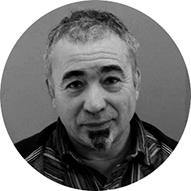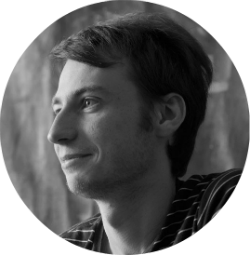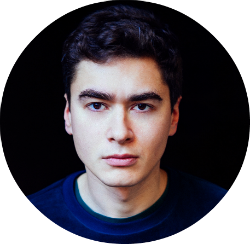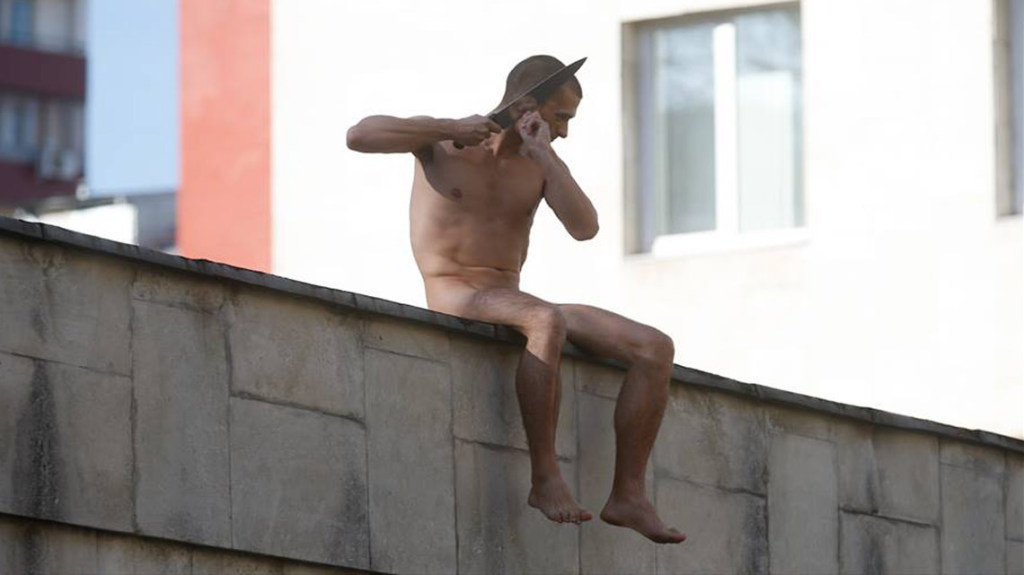Earlier this month, two notable art performances took place in Russian cities. On the morning of 5 November, on the river Moyka near Nevsky avenue, a group of “anarchists and libertarian socialists of Petrograd” set afloat two plain pine coffins, also known as “Cargo 200,” with inscriptions reading, “For what?” and “For whom?” According to the performers, these are two crucial Russian questions nowadays. Later, at night on 9 November, Petr Pavlensky set on fire the entrance of the Russian Federal Security Service headquarters, the notorious Lubianka in Moscow.
Pavlensky’s performance became perhaps the most radical and disputed since Pussy Riot’s performance, and produced numerous discussions in Russian art and activist community. It once again posed a question about the condition of political activism in Russia, and about the possibility of artistic statement after such a powerful gesture. What to think of Pavlensky’s action and what are its possible consequences? These questions were answered by artist and member of the Chto Delat (What to Do?) group Dmitry Vilensky, a union and left activist Maxim Kulaev, cultural scholar and performer Anastasia Dzyuban, and artist Nikita Kadan.

Dmitry Vilensky, artist, activist, member of the group Chto Delat?
Pavlensky’s performance has deafeningly resounded in the media sphere, and once again forced society to face very difficult questions. This is enough to be seriously grateful to him and show maximum respect for his courage, persistence, and dignity. In the current situation, it is important to demand that the trial takes into account his intentions and is strictly in accordance with the law (although that is, as experience shows, barely possible). And, of course, it is important to draw the first conclusions from the situation.
The challenge in the core of Pavlensky’s performance as an artistic statement is the fact that it blocks the possibility of communication. Artists always reply to a poem with another poem, to a film with an exhibition, to a performance with a seminar or a play, etc. This is how the chains of inspiration work, as well as, in their turn, the chains of political mobilization. The key problem of Pavlensky’s action is that it, in its hermetic perfection, reproduces the logic of symbolic moralizing violence against the ultimate evil, driving the situation into the state where any “lowering of the degree” turns out to be irrelevant, a priori unnoticed, weak and simply meaningless. The evil must be burned out — “Burn, oh Lord, burn!” This beautiful and honest gesture absolutizes power and is performed within a situation of absolute lack of both the revolutionary situation and the revolutionary subject, which logically leads to a victimization of the remains of the destroyed opposition movement and left community. Only a lonely romantic hero remains, separated by his deed from his artist colleagues, from activists, and from society. It is a powerful image, but it further paralyzes the possibilities for further development of politically thinking citizens, because it does not offer any practical model for mobilization.
There are real grounds for speculation about the fact that Palensky was followed by the state services, who waited for the moment when he rises to an action that could be used on a different level for public manipulation. I discussed this moment with him personally a couple of times, and Petr was well aware of it (we thought that it would be used right before the election, but probably a strategy for the future had already been developed?). “Curators” (not from the art world) have enough talent to realize that Petr had the most serious potential to reach another, less metaphorical sense, as in his previous works, and arrive at direct action. And they were not wrong. This performance, from what one can get from the first official comments, is already set to become the “model” for the demonstration of the total “insanity” and dangerousness of both the opposition and contemporary art in general. It is worth honestly admitting that, at the moment, the authorities have many more strategic mechanisms for using and creating its “added value” than society has. And Pavlensky has nothing to do with it by this point, he honestly and consistently did his job, and did it excellently. He set to reach a noble goal to desperately provoke another round of struggle, and will use his trial as a platform for speaking out, as only he can do with such brilliance (he already had a chance to speak with dignity at the first court meeting). But those who stayed outside prison have to acknowledge that, most probably, a new game is starting, and we have to get ready for it. Having discarded all the romantic pathos of the performance, we must move its call onto the plane of daily collective work, without which any, even most humble, project of liberation is impossible. We must heighten our alertness, not fall into hysteria, not react to provocations by the authorities (which will certainly follow now), and do everything possible to defend Petr from the fate of Sentsov and Kolchenko.
Otherwise we will lose everything we have left, and very soon very few people will want to remember that the performance ever happened.
 Maksim Kulaev, union and left activist
Maksim Kulaev, union and left activist
In Russia, it was always difficult to engage in political activities. As early as ten years ago we faced the problem of choice: what forms of struggle should we use if we cannot hold a large rally anyway, but people are insensitive to regular propaganda (leaflets, newspapers)? The situation worsened after the protest against election fraud in 2011/12 and all the events in Ukraine in 2014. So far, even the economic crisis, the worst since the 1990s, has had hardly any impact on the attitudes of the majority of Russian citizens. Paraphrasing the press statement about the action Crucial Russian Questions 2.0, there is no point in asking, What to do? The answer is clear: “You will fail anyway”. Political activists are demoralized. Social movements and independent labor unions are stagnating.
Actionism was always a way out, ten years ago as well as now. Many people (including me) see it rather as another form of propaganda. One can say that actionism exists here in parallel to left art and philosophy. However, left art and philosophy in Russia are also in crisis. They give barely anything to protest and resistance now. Rather, they take on the role of entertainment or, even worse, a sort of escapism. Maybe five years ago they still worked, but not now. From this point of view, the performances of Pavlensky, who is both a real artist and an actionist at the same time, are undoubtedly more important and more useful, if one can speak in utilitarian terms. The sense of his activities is perfectly readable by the public, which is always clear from the reaction on social networks and even the major media. His actions precisely point out society’s problems, from persecution of the freedom of speech, to the avalanche of repressive laws, which have constantly been passed in the past four years. Pavlensky feels the social demand much more acutely than his critics. Among other things, he helped unions to decorate their visual propaganda a couple of times. And this is at the time, when the mass of artists, left activists, researchers look at workers’ organizations with either incomprehension or poorly disguised contempt. Moreover, it is worth pointing out the high level of organization of his activities. Many activists must learn from Peter to be technical and elaborate.
In general, so far our toolkit is not the most diverse. On the one hand, we organize performances as a means of propaganda: an anti-war picket in the center of Saint Petersburg would draw much less attention than the coffins floating down the river in that same area. On the other hand, we do our daily work of building grassroots organizations and creating infrastructure. It is a very unrewarding work, to be honest.
 Anastasia Dzyuban, cultural researcher, performer, member of Peer_Forma Group
Anastasia Dzyuban, cultural researcher, performer, member of Peer_Forma Group
When we speak about political actionism or art actionism, we, obviously came across a kind of uncertain gray area between art and politics, where operating with any terms becomes a hard task. On the one hand, it’s impossible to affirm that art and politics are fully contiguous, but on the other hand, it is almost impossible to divide them.
Today many historians and theoreticians of art are trying to understand the reasons of such collaboration between these two institutions. For example, Russian philosopher and cultural researcher Vitaly Kurinnoy, explains this cooperation by pointing to the fact that in times when art was actually equated with a craft (techne), it was never autonomous. Instead it was always submitted to one or another social institution (including religious ones). But contemporary art (whenever we define its “beginning”) has radically rejected its links with institutions of power and gained its autonomy. Of course, under these conditions it became more and more difficult to create any description and definition of the boundaries of art.
As Mikhail Iampolski said – there is no art anymore – what we have are some different “anthropological practices of the comprehension of the world”. In my opinion, today all avant-garde art practices itself are already political, as they are opposing the decorative arts and craft (if we understand politics not as a specific institution that is separated from society, but as an ongoing process of the transformation of the status quo and a certain type of thinking about being as such, that can (and should) be changed). That’s why it’s not so important to ask the question whether the activism/actionism of Pavlensky, Voina, or Pussy Riot is politics or art, because any avant-garde (non-decorative) art practice is political itself.
The recent action of Peter Pavlensky – setting fire to the Moscow headquarters of the country’s security service, the FSB, as well as the recent action of the “Art group of anarchists and libertarian socialists” – Crucial Russian Questions 2.0 (which, however hasn’t gained such media coverage) – are both a kind of game of the values and concepts set against the apparatus of power.
Among the questions that were asked – “Vandalism, terrorism or art?”, “For whom?” and “What for?” – we could recognize the most current contemporary phrases. And different discourses are competing so diligently to define or rather to impose their meaning of these conceptions. Pavlensky demands that he be called a terrorist to respond to the logic of the system. The abstraction of St. Petersburg`s anarchists verges on directness and specificity, which means their gesture cannot lose. Maybe precisely such an incorporation into the rules of the game of the system can undermine it from within?

Nikita Kadan, artist
One of the main features of Pavlensky’s gestures is their ability to block additional issues and to limit the space for any comments, to cut off the unimportant, to point to the correct viewpoint.
The effect that accompanies these actions is the following: the “veterans” of the contemporary art, who are reasoning whether one or another action was good as an art gesture and whether it was made as an art gesture at all, as well as activists, who see these actions as pure reactivity in the absence of an alternative to the dominant political project – t hey both inevitably begin to look like small envious reptiles. They are no longer particularly different from both the self-satisfied news consumers who evaluate other people’s self-sacrifice, and from “Putin’s majority”, who are calling for the return of punitive psychiatry. There is nothing to tell? – Then do not speak. What is important – that is obvious. Everything else is just a means of escape from this evidence, transactions with a dirty conscience, attempts to close one’s eyes.
These issues remain open: repression and the lies of Russian power, hostages of the political regime, a weakness of the protest movement, a lack of solidarity. A number of gestures were made in which a potential subject of resistance sees the evidence of thier own failure, which should make them feel ashamed and, finally, turn to action. It’s a sequence of blows that hammers a nail into the head. Did you get it? – Well, here it is one more time.
A lot has already been said about the fact that Pavlensky skillfully constructs a spectacular image and uses very traditional artistic means along with many others, so there is nothing to add. I think it should be clear that he has a right to pretend to be in the territory of art and to take from this territory any aesthetic achievements and to use them exclusively in his activist practice.
Pavlensky returns commonplaces their meaning: “an urgent need of solidarity” – at least for a while, an almost unbearable specificifity appears again in these words.
Translated by Nataliia Lomonosova. Originally published at Політична критика www.ukraine.politicalcritique.org
Read more
Paweł PIENIĄŻEK: Pavlensky will not be threatened
![Political Critique [DISCONTINUED]](http://politicalcritique.org/wp-content/uploads/2015/09/Political-Critique-LOGO.png)
![Political Critique [DISCONTINUED]](http://politicalcritique.org/wp-content/uploads/2015/09/Political-Critique-LOGO-2.png)
